calsfoundation@cals.org
Agriculture
Agriculture has played a major role in Arkansas’s culture from territorial times, when farmers made up more than ninety percent of the population, through the present (about forty-five percent of the state’s residents were still classified as rural in the early part of the twenty-first century). Beginning as a region populated by small, self-sufficient landowners, the state evolved through a plantation culture before the Civil War, to an era when tenant farming and sharecropping dominated from the Civil War to World War II, before yielding to technology and commercial enterprise. For more than 150 years, agricultural practices had hardly changed. Hand tools and draft animals limited an average farmer to cultivating about four acres a day and made it difficult to accumulate wealth. But World War II transformed agriculture, and in twenty-five years, machines turned what had been a lifestyle into a capitalistic endeavor.
Prehistory
Geography played a key role in shaping Arkansas agriculture. Divided into six regions, each with unique soils, the state presented a variety of choices. One of the largest farming regions, the Mississippi Alluvial Plain (formed by the Arkansas, Mississippi, and Ohio rivers), stretches about 250 miles from Missouri to Louisiana. Nearly 200 feet above sea level, the elevation varies less than 150 feet. Over the past two million years, rivers carried soil particles from the upper Midwest and cut through thick loess deposits in the lower Mississippi River Valley. Flooding was frequent, and as the water rose out of the normal river channels, the principles of hydrology caused the heavier, coarser soil particles to fall to the bottom. The lighter, finer soils were carried farther from the main source. Over time the coarser particles (sand) built a dike along the riverbank and frequently prevented water carrying finer particles from returning to the main channel. Trapped in stagnant pools, these waters formed backwater swamps, and the finer particles coalesced into clay.
The rushing floodwaters also changed course frequently, carving new channels and leaving the old river behind as oxbow lakes and bayous. The almost constant flooding also challenged plant life, and two types of vegetation came to dominate. More than ninety percent of the region was covered with trees, eighty percent of which were bottomland hardwoods. The other vegetation was a rhizome grass the local population called cane. It grew in such dense stands that early travelers from Memphis, Tennessee, to Little Rock (Pulaski County) often hired guides to get through it. The flooding also helped shape two distinct Delta subregions. One of these, the Grand Prairie, a vast treeless region between the Arkansas and White rivers, occupies more than 500,000 acres of natural grassland in the south-central section. The other, Crowley’s Ridge, was formed by windblown dust deposited before the rivers flooded. It rises more than 200 feet above the floodplain and varies up to ten miles in width as it stretches 150 miles from the Mississippi River at Helena (Phillips County) to the Missouri border near Corning (Clay County).
The state’s first agriculture began in the Grand Prairie–Crowley’s Ridge region. Almost 3,000 years ago, the Pre-Columbian Woodland people began growing food to supplement their hunter’s diet. Living in small villages characterized by earthen burial mounds, these Native American peoples planted vegetables and grains by tilling with hand-held wooden tools. The Mississippian culture that supplanted the Woodland people kept some of their vegetables but added corn and became almost exclusively dependent upon this new grain for food. Cotton, the crop most identified with the Delta, did not appear until after the United States acquired the region with the Louisiana Purchase. The dead river channels were some of the first lands sought out by the white American cotton farmers arriving from the East in the 1820s.
In southwest Arkansas, the Red River formed another alluvial plain and shared some of the same qualities of the Mississippi River region. It had oxbow lakes, swamps, and dense undergrowth that presented a challenge to early farmers. But the Red River valley sat higher and was not as subject to flooding, and the soil had a sandy loam rather than clay base. Because it required less effort to cultivate, it became the first region to be dominated by the cotton monoculture.
Between the Mississippi and Red River floodplains lay the West Gulf Coastal Plain. Formed by erosion from the upland regions, the Coastal Plain was characterized by shallow soils that were excellent for growing loblolly pine trees but had limited use for traditional row crops. Cotton and corn farmers survived by planting in the Ouachita–Saline River watershed valleys.
West and north of the Mississippi River floodplain lay the Ouachita Mountains and the Ozark uplift. Farming in these regions was also a challenge. Soils were shallow, the terrain usually sloped, and most of the nutrients leached out through centuries of erosion. There was some fertile land along the many streams that drained the upland watershed, but these valleys were typically narrow and subject to flooding. A crop lost to floods often offset soil fertility.
The Arkansas River Valley bisects the Ozarks and the Ouachitas and offered the best farmland in the upland region. Beginning on the state’s western border, it ranges from twenty-five to thirty-five miles wide and extends almost 150 miles into the state. Originally valued for its cotton land, by the time of the Civil War, the region had the state’s most diverse agriculture.
Agriculture in the Nineteenth Century
Before 1840, the upland region dominated production. Most farming was done on hillsides, and even though many of the early immigrants staked out more than 100 acres for a homestead, their farming operations were usually far less. A typical hill country farm through most of the nineteenth century had about thirty acres in cultivation—ten acres of corn, five acres of cotton, and the rest in cereal grains, sometimes tobacco (particularly in the Ozarks), potatoes, and vegetables. The remaining property was open range for livestock, was used for hunting or fishing, and was a source for firewood, wood for tool handles, roofing shingles, and other needs. Such farmers usually made enough from cotton to pay taxes and buy a few finished goods.
After 1850, commercial agricultural in the Delta eclipsed subsistence farming. Cotton became the dominant crop as white Americans discovered that the alluvial soil typically produced about fifty percent more cotton than the state’s average pounds per acre, and Delta raw cotton regularly sold above market price at the Memphis cotton exchange. In the decade before the Civil War, the region’s population increased more than 100 percent, and the slave population grew more than 120 percent. But even then the plantation cotton-slave culture exceeded the self-sufficient hill farmers’ only in the dollar value of their investments in chattel and land.
In some ways, the Civil War had a major impact on Arkansas agriculture, but in others, little changed. The most obvious change came after 1863, when the Emancipation Proclamation freed Arkansas’s 111,115 slaves. Related to that were the thousands of acres of farmland that lay fallow, some for the duration of the war, depriving individuals and the state government of income. Perhaps the most divisive impact of the war was a Confederate policy that allowed those owning twenty or more slaves to be exempt from military service. Historian Carl Moneyhon established that many large landowners persisted through the war and continued to dominate Arkansas agriculture economically after the war.
As the war ended, federal army officers confiscated some of the abandoned land and used it to resettle former slaves. These “home farms,” established both in northwestern Arkansas and in the Delta region outside Little Rock, Pine Bluff (Jefferson County), and Helena, provided a few African Americans with their first experience in managing their affairs independently. For most, having spent their lives close to the soil working crops and livestock with a limited selection of tools, continuing in agriculture was expected. But gaining access to farmland was a major challenge. In response to the former slaves’ need for land, Congress adopted two programs designed to make individual land ownership a priority. The first extended the responsibilities of the Freedmen’s Bureau to assist with farming. The second came in 1866 with the Southern Homestead Act, which provided “free land” from the public domain in the former Confederate states. Arkansas was second only to Florida in acres still in the public domain and offered an opportunity for thousands of Arkansans, black and white, to own farms free of charge. Almost twenty-seven percent of Arkansas’s acreage lay unclaimed, and more than eighty percent of that was in the Delta. The bill initially limited public land access to homesteaders and limited individual claims to eighty acres, rather than the 160 acres in the original 1862 bill. To ensure that Black farmers had the first opportunity to file, individuals “taking up arms against the United States” were denied access to public land until 1867. President Andrew Johnson signed the bill into law on June 21, 1866.
For ten years, the Southern Homestead Act was an experiment in public land reform, placing individuals using the land above the speculator. But lofty though its goals, and as well intentioned as its sponsors may have been to help the Southern underclass, it was not a panacea. Black farmers were slow to sign up for the new lands and even slower to finalize their claims, for several reasons. The bill did not become law until the third week of June (too late to plant cotton), and the General Land Office was slow to reestablish offices in the seceded states. In Arkansas, the main office did not open in Little Rock until October 1868. While the state was fortunate to have two additional offices—one in the Arkansas River Valley west of Little Rock and one in southwestern Arkansas near the Red River—all were far from the Delta and most of the public land. Immediately after the war, confusion and uncertainty made it difficult for freedmen to take advantage of the legislation.
In 1867, only 167 freedmen made claims in Arkansas. The next year, 161 filed. The numbers picked up over the next eight years. But even as late as 1876, when the original legislation was amended to allow for “unrestricted access,” there were only 26,395 “original entries.” These individuals claimed 2.3 million of the nine million acres set aside in 1866. But fewer than half (12,680) of the original claimants lived on their homesteads long enough to make a final entry.
Congress’s amending the Southern Homestead Act led to a wave of speculation as representatives of timber and railroad companies descended on the South to buy millions of acres from the public domain. Buyers representing seven Northern companies bought 114,334 acres in Arkansas between 1876 and 1888. Additional purchases by Arkansans pushed the acquisition of public lands to 628,744 acres. By the time Congress took steps in 1888 to again limit access to the public domain, Arkansas had few public lands left. Thousands of acres were now under the control of private companies that saw little reason to assess the land for its true market value. Not only did these companies deny the state tax revenue by taking land off the market, they deprived the state of even more revenue by transporting resources out of state for processing.
By the time the act could be implemented effectively, a new form of agricultural labor had taken shape. Wage contracts, adopted as a necessity in the 1866 crop year, quickly evolved to tenant and sharecropping contracts that allowed the underclass farm hands and the landowners to meet mutual needs. The landlord-tenant sharecropping system quickly ran into economic problems. The tenant sharecroppers were frequently forced to borrow money to buy supplies and tools to farm and pledged their future crop for security. Typically, in a matter of several crop years, small farmers found themselves encircled by debt.
In addition to the credit crunch, farmers in the last quarter of the nineteenth century faced a steady decline in crop prices. From a high of fifty-two cents a pound on the Memphis market in 1866, cotton prices began a downward trend that reached a low of 6.5 cents for the 1899 crop. In that period, the price averaged about eleven cents per pound and the price increased, marginally, only eight times. Low prices, coupled with erratic weather patterns and periodic bollworm infestation, challenged even the best farmer.
To avoid or escape the credit-debt trap of single crop agriculture, and in keeping with the New South emphasis on diversification, some farmers turned to fruit and vegetable farming. Apples were the crop of choice for landowners in the northwest hill counties, particularly after the Missouri and North Arkansas Railroad extended east from Eureka Springs (Carroll County) in the 1890s and allowed growers to ship to outside markets. However, disease infested most orchards less than two decades after apple growing became commercially feasible. Despite significant efforts by scientists in the University of Arkansas’s College of Agriculture to control disease and pests and to develop new varieties, apple producers have not been able to regain a significant share of the market from the Pacific Northwest.
Peaches, another crop in the New South diversification movement, were also grown in all sections of the state, but commercial growers were most successful in the upper Arkansas River Valley, centered in Johnson County, and along the slopes and valleys of the Ouachita Mountains in southwestern Arkansas, with the largest concentration in Howard County. Strawberries also began to have some commercial success by the early twentieth century. Also originating in the northwest counties, the industry came to be concentrated in a narrow district between the Little Red and White rivers in the north central region of the state.
For two very different reasons, viniculture also developed in the state in the late nineteenth century. The first vineyards were established in the upper Arkansas River Valley in the 1870s by Swiss-German immigrants lured to the state by railroad agents promising fertile land at cheap prices. The Roman Catholic Diocese of Little Rock, which covers the entire state, was also active in recruiting immigrants to settle on land the Church purchased from railroad companies. Starting with home consumption, some family-owned wineries were able to expand their operations to be commercially successful and survive almost two decades of Prohibition by producing communion wine for churches. Arkansas is now recognized as the location of three American Viticultural Areas.
The other grape-growing region in the state was established in the northwest in the 1890s by Italian immigrants. Originally brought to southeastern Arkansas to work on cotton plantations, like Sunnyside Plantation, a band of these “aliens” migrated to Washington County and established a self-sufficient community, centered upon Tontitown (Washington County), in part by growing grapes. With their product valued more for juice than wine, grape growers in the northwest became a success by producing for commercial canneries. Juice grapes continued to be a viable industry into the 1980s before market forces put most of the growers out of business.
Tomatoes also became a commercial success in the twentieth century, particularly in the southeastern regions of the state. Bradley County earned the reputation as the “tomato capital” of the state, and selective breeding by crop scientists at the University of Arkansas’s College of Agriculture kept tomato growers in a competitive position in the twenty-first century.
Historically, however, most Arkansas farmers in the nineteenth century were not able to diversify and turned to political activism to try to improve their economic standing. Some sought out national organizations such as the Patrons of Husbandry (Grange); others tried local groups, including the Brothers of Freedom and the Agricultural Wheel. The latter evolved into the Southern Alliance, extended beyond the state’s boundaries, and ultimately merged with a Northern group to become the People’s Party of America (Populist). Black and white farmers joined these “improvement societies” but maintained separate affiliations.
Early Twentieth Century
Cotton prices and farm income reached their lowest post–Civil War levels in 1899. Conditions improved for two decades, and farmers realized a prosperity unmatched in American agriculture. Much of the farmers’ improved situation was due to World War I. Wartime demands for food and fiber led to a “golden age” in agriculture when cotton prices approached their Civil War levels. Many war veterans, attracted to the artificially high prices in farming, bought land and frequently went into debt to do so. By the early 1920s, falling prices and rising surpluses created a crisis in rural America as thousands of farmers lost their land to foreclosure and were forced back into tenant farming and sharecropping. Again, farmers turned to activism. Efforts to persuade Congress to adopt a federal farm bill to shore up prices failed when government officials argued such a bill would create larger surpluses and further complicate the problem. It took the Great Depression to persuade Congress to enact legislation that addressed farm production.
The 1930s were difficult for almost all Americans, but for Arkansas farmers, the Depression started with the Flood of 1927, a disastrous flood along the Mississippi River and its tributaries. By June, water covered more than 6,000 square miles and all but destroyed the row crops. That year also saw a precipitous drop in housing construction and a downturn in the forestry industry.
The commercial timber industry in Arkansas began in the 1880s and reached its peak around 1910. Companies invested large sums of money in developing the infrastructure: harvesting, hauling, and milling. Many company towns were established in the upland regions, and before 1930, hardly a family in the hill country was not involved, at least indirectly, in the forestry business. But in 1927, lumber prices began a rapid decline that continued for more than five years. Most small lumber companies were forced into merger or bankruptcy. Hundreds of people in the hill country were laid off.
Just as rural Arkansans were adjusting to their losses from the flood and the timber industry changes, another natural disaster struck. The drought of 1930–31 became almost as legendary as the flood. Rainfall had typically been an ally for farmers, but from April 1930 to January 1931, “measurable precipitation” was far below average. In August 1930, the official reporting station in Little Rock recorded its seventy-first consecutive rainless day. While not as severe as the Dust Bowl conditions of the mid-1930s, for Arkansas the drought’s effects were still devastating. Many had to seek public assistance. When state and private charities failed to meet the need, federal officials established a Drought Committee to review conditions and provide low-interest loans for farmers to use in buying farm supplies and forage for livestock.
Public assistance proved too limited and restricted, and families were forced to seek their own remedies. For some, this meant moving from their cherished farmstead. Some moved out of state; others gave up farming and relocated to the larger towns in their region. Still others migrated from the upland counties to the Delta counties and initially hired out as day laborers on the area’s larger cotton plantations. At six cents a pound, standard wages for “first picking” in 1930, a hard worker could make six to eighteen dollars a day.
The intrastate migration from the western hill counties to the eastern lowland counties interjected a work ethic that had been missing in the traditional plantation culture and its paternalistic social relationships. By settling on land that local farmers deemed undesirable or less desirable, newcomers contradicted the traditional land-holding pattern. Not knowing that the soil was untillable, the former hill farmers taught their neighbors a lesson about determination and will. Desha County, which had 26.9 percent of its acreage in cultivation in 1925, had 40.5 percent in 1940. Other Delta counties showed similar increases. By challenging conventional wisdom, many formerly destitute farmers gained economic success and convinced traditional farmers that almost all the land in the Mississippi Alluvial Plain could be profitable.
For many of the farmers new to the Delta, a key was in growing rice instead of, or in addition to, cotton. The marginal “buckshot” soil avoided by traditional cotton farmers was ideal for rice. Also, when federal officials established production controls on cotton in the Agricultural Adjustment Act of 1933, some landowners turned to rice. Rice, which had been grown commercially since the turn of the century, saw a rapid increase in acreage after the 1930s.
World War II through the Modern Era
World War II transformed Arkansas agriculture. The combination of increasing demand and rising prices for farm products, alternative job opportunities, and increasing use of technology changed the nature of farming in a generation. In 1940, tenants or sharecroppers cultivated more than sixty percent of the land, and more than ninety percent of farmers used horses or mules as draft animals. By 1964, the statistical importance of tenant-sharecroppers, and the number of horses and mules, had been reduced to the point that federal officials no longer collected data on them. The significance of the changes lay in the speed in which they occurred. Cotton had been the state’s bellwether crop, but by the end of the war, rice and soybeans appeared and quickly won a loyal following. After a few years, most farmers were convinced that the relative ease of producing soybeans made it the crop for the future. Rice, too, because of its greater economic return, found increasing favor in the Delta. Most farmers were willing to make long-term commitments to these crops even though it meant acquiring new equipment.
The new equipment came primarily in the form of tractors and improved planting and harvesting machines. Tractors, although making an appearance in the Delta soon after World War I, were at first impractical due to poor design, high cost, and the dominance of small-scale sharecropping and tenant farming in the state. However, World War II brought dramatic changes in the area of farm equipment. Not only did technologies developed in the war greatly improve the machines and reduce their costs, the mass migration of rural Arkansans to defense plants in regional towns reduced the number of farms and increased the size of farming units. Using money saved from wartime prosperity, farmers were poised in the postwar period to buy machinery and land to expand their operations. When many of the small farmers did not return to the land after the war ended, as they had following World War I, landowners were forced to rely on machinery even more. Rice and soybeans incorporated into this new order since the same harvester could be used for both crops with only limited modifications. A new age in Arkansas agriculture had begun and was reflected in changing land and cropping practices.
In 1940, Delta counties cultivated only 153,000 acres of rice and 176,000 acres of soybeans, compared with 1.2 million acres of cotton; those figures changed dramatically in the next twenty years. Reasons are complex, but the Delta’s geography is among them. The new agriculture could not have developed without significantly altering the area’s two most significant features—trees and wetlands. These natural barriers confounded Americans for more than 100 years after the first farmers arrived in the 1820s. With limited tools and technology, they were at a disadvantage when taking on the swamps and forest. As late as 1940, more than half of the Delta was undeveloped.
Some effort had been made at ditching and draining the Delta’s wet spots before World War II, but inadequate equipment limited the efforts. Before the war, cotton’s low tolerance for heavy, wet soil presented farmers a challenge in maneuvering their fields amid the forest and finding elevation high enough to avoid overflow. By World War II, most of the acceptable cotton land was in cultivation. Cotton acreage continued to increase until 1955, but the growth was much smaller compared with that of rice and soybeans, and farmers focused on those crops. The new crops were aided in part by new technology, which made it possible to drain and dredge swampland. Wartime technologies produced giant, self-propelled, rubber-tired scrapers that could transport fourteen cubic yards of dirt, and they were highly mobile. This equipment made it possible to bring new land into cultivation, ideal for rice and soybeans but not cotton.
Other technologies aided farmers in altering the Delta landscape. Refinements in the torque converter and power shift transmission, when applied to a tractor equipped with cutting blades and tree pushers, allowed one man to clear more trees in a day than a family could in a lifetime using traditional means. For a time in the 1950s and 1960s, timber removal in the Delta became a full-time business. From 1940 to 1978, about 2.5 million acres of forest were cleared and most of that land was brought into cultivation. In previous years, much of the timber had been cut for lumber, but after World War II, the normal practice was to push the downed trees into rows and burn them.
The rapid and extensive disappearance of the hardwoods in eastern Arkansas created controversy. Game and fish enthusiasts and environmentalists worried that clearing for crops would despoil the region. Critics of the clearing practices noted that the hardwood environment provided a unique habitat for certain animals and feared that those species would be lost. Years of public debate and meetings led to a compromise in the 1970s that balanced agricultural and non-agricultural interests. Public policy was equally important in shaping agriculture in eastern Arkansas. In 1954, Congress passed the Watershed Protection and Flood Prevention Act, designed “to improve land already cleared for either crops or pasture” by channeling and damming streams that were prone to flood. In the next fifteen years, twelve watershed districts were formed; eleven were in the Delta.
The eleven flood-control projects resulted in more than 400 miles of stream channelization and brought 4.7 million acres into drainage districts. After 1970, federal officials modified the program and took steps to limit the acreage being developed for agriculture. But by that time the Delta’s 4.4 million acres in forestland had been reduced to 1.8 million acres and half of the original 7.7 million acres of swampland were in drainage districts.
There was a correlation between clearing and drainage projects and an increase in soybean and rice production. These crops brought diversification to the Delta’s agricultural practices that generations of spokesmen had only dreamed about. Soybeans, the more versatile of the two, gained in popularity over rice. Beans became the crop choice for Delta farmers a decade after the war. In 1945, about 4.5 acres of cotton were planted for each acre of soybeans; by 1955, acreage of the two crops was almost equal, and by 1960, there were more than six acres of soybeans per acre of cotton. Part of this change was a reflection of market conditions, but more significant was that soybeans were better adapted to Delta soil—particularly the newly cleared timberlands along the swamps and bayous.
An unanticipated argument for growing soybeans came in the early 1960s when the environmental movement began calling attention to the impact pesticides and herbicides were having on plant and animal life. Requiring fewer “additives” than rice or cotton, soybeans could be produced more cheaply and were more environmentally safe. Being an important source of protein, the bean was also viewed by some as a suitable alternative to meat products while being more compatible with existing ecosystems.
Public policy also influenced the shift from cotton to soybeans. The federal Farm Bill of 1956 instituted a new plan for cotton producers. The traditional price support was continued, but to qualify for a subsidy, farmers had to take a designated amount of cotton acreage out of production. Policymakers conceived this “soil bank” program as a way to reduce surpluses in cotton and other commodities. To some extent, it worked, but a more significant outgrowth of the policy was the acceleration of soybean production. Farmers, faced with limits on cotton, turned to soybean production with a passion; market prices were high through most the 1960s and 1970s.
Similar forces were at work to spur an increase in rice acreage. Once thought to be unique to the Grand Prairie, success came for rice farmers in the new drainage districts. Also, initially exempt from acreage controls, rice provided a good alternative to cotton farmers in the same way soybeans had. By the 1970s, Arkansas consistently led the nation in rice production.
High prices and the availability of newly developed land led to a boom in Delta agriculture in the 1970s. Opportunities for quick profits attracted a variety of new farmers and non-farm investors; many were unfamiliar and unconcerned with traditional cropping practices. They approached farming strictly as a business enterprise, and their entry quickly drove up land prices. The boom peaked in 1982, when the average price in the state reached $1,095 per acre. Some Delta land, already cleared and drained, brought $2,500 per acre.
A final public policy issue that contributed to the agricultural revolution in east Arkansas had to do with labor relations. The need for workers in wartime industries drained rural Arkansas of farm workers in the 1940s. By 1943, the nation faced a critical labor shortage and turned to Mexico for workers. The Bracero Program brought thousands of immigrants to the fields and orchards of the United States. When most domestic workers did not return to rural America after the war, a treaty between the United States and Mexico formalized the plan. From 1948 to 1964, Mexican day laborers filled a vital need for field hands in the Delta.
Agriculture in western Arkansas experienced a different type of revolution after the war. Unable to meet the competition offered by their east Arkansas neighbors, hill country farmers turned from grain and row crops to poultry, livestock (especially swine), and timber. Laws favorable to small-business development encouraged partnerships between poultry growers and processors and a redevelopment of land use. Fields that once grew cotton and corn now housed structures for thousands of chickens. Farmers provided land and labor while processors offered chickens, feed, and a contract to buy the products. Many farmers applied chicken manure to reenergize pastureland for livestock.
Beef cattle became an increasing part of the rural scene in the counties west of Little Rock after World War II. Prior to that time, few landowners raised cattle exclusively, although most homesteads had a few head of livestock, including milch cows. The state’s climate did not favor the beef industry. Extreme heat and humidity of the summer months and parasites such as ticks, mosquitoes, and screw worms presented serious challenges to cattle. Most ranchers did not engage in scientific breeding to improve herd quality, and a high percentage of their animals lived on open range. However, cattle raising changed dramatically after the mid-1950s when New York transplant Winthrop Rockefeller arrived in Arkansas. One of his first actions was to introduce Santa Gertrudis cattle in the state, a breed specifically developed in south Texas to thrive in the region’s hot weather and multiple pests. Not only did Rockefeller import new cattle, he also started a scientific breeding program that included an annual bull sale featuring prize-winning animals. In short order, other cattlemen began their own “experiments” in raising blooded stock and improving their offspring through genetic breeding. By the twenty-first century, about sixty percent of Arkansas farmers raised cattle. Typically, the cattle operations were on family farms. According to industry records, the average herd size by 2020 was thirty-five head, and eighty percent of the approximately 24,000 cattle farms in the state had fewer than fifty head of livestock. Over one half of the state’s farms are cattle farms.
Dairying also experienced dramatic changes in the post–World War II period. Throughout the nineteenth century, landowners concentrated on draft animals, horses, mules, and oxen, with only a passing interest in dairy or beef animals. Before sharecropping and tenant farming became the dominant cropping pattern, most farmers owned a milch cow, and most towns of even a few hundred people were served by at least one dairy. Breeds such as Jersey and Guernsey were more valued for the high butterfat in their milk, but as with beef animals, little attention was given to scientific breeding. Growing urbanization in the twentieth century, changes in technology, and knowledge about transmitting disease through raw milk brought many changes to the dairy industry. The extension of electrical power to rural areas, beginning in the 1930s, also affected dairy farmers. Mechanical milking machines, new techniques in pasteurization, homogenization, and refrigeration—coupled with improved transportation—brought modernity to the industry. As with row cropping, however, increased technology brought increased investment costs and greater capitalization. By the early part of the twenty-first century, family farm dairying had largely disappeared, with Arkansas having just over 40,000 dairy cattle and 420 dairy farms. By 2020, the number of dairy cattle had dramatically dropped to fewer than 5,000 cows and there were only forty registered dairy operations in the state.
In other areas, particularly the Coastal Plain, farmers converted cropland to timber farms. The building boom that began at the end of World War II and continued with the baby boom into the 1960s accelerated the need for lumber and its by-products. Farmers now found it more profitable to grow trees on land that had been used for cotton and corn.
By the mid-1980s, the state’s agricultural revolution was largely complete. Single crop, hand-labor production had been replaced by diversification, mechanization, and chemical and biological practices. As historian Gilbert Fite noted, farmers became a new minority in many regions of the nation, and that was particularly true in eastern Arkansas. But after World War II, most Arkansas farmers were also a new elite. Costs of machines, land, and “inputs” had forced out all but the most skilled and daring farmers. Heavily capitalized, with access to thousands, sometime millions, of dollars, these farmers were products of an agribusiness system. But even modernization did not remove the risks. In relative terms, the new agriculturists were in no better economic position than their traditional forebears. Greater investments meant higher risks, and between 1985 and 1995, more than 11,000 farmers left the Delta, victims of debt, low prices, and bankruptcy. Less pronounced but still significant was the number of upland farmers hit by similar forces. Between 1935—when farms reached an all-time high of more than 235,000 units—and 1995, the number dropped steadily before leveling off to just under 50,000 farms.
One of the most significant changes in Arkansas agriculture came in social relationships. Altering the landscape—whether clearing forests, draining swamps, channeling streams, or replacing cotton with rice and soybeans or chicken houses and cattle—transformed the rural culture. Ironically, while millions of acres were being brought into cultivation, thousands of people were leaving the land. The way of life that had sustained them for generations was rapidly dying. Not only was their occupation gone, but also was the land that served as a source for food, fuel, and leisure.
As the demographic shifts occurred, rural Arkansas developed pockets of settlement occupied by people without land and dependent on a day wage. They were particularly susceptible to the cyclical fluctuations of prosperity and recession and progressively lost economic control of their lives. Without regular incomes, they became dependent on public housing and food subsidies and spent an extended amount of time unemployed, even as landowners hired Latino migrant workers as day laborers. These former sharecroppers and tenant farmers were not the source of the new agriculture but rather were reflective of its change
Even those farmers who remained on the land faced greater uncertainty than ever before. Criticized by sportsmen and environmentalists for misusing the land, polluting streams, and altering habitat for wildlife, Arkansas farmers have increasingly lost debates on public policy issues involving their industry. Conflict with non-farm groups reached a climax in the 1996 Federal Farm Bill, which defined environmentally sensitive land and restricted farming practices in what was termed “wetlands.” In addition to policy regulations, farmers also faced constraints from resource depletion. In many areas of the state, groundwater has been depleted at a rapid rate, and rice farmers, in particular, face difficult choices between replenishing the aquifer and impounding surface water—or even leaving farming. Despite repeated efforts since 1948 at both state and federal levels to adopt a water use policy, little progress has been made. How the water issue is decided may well determine Arkansas agriculture for the twenty-first century.
For additional information:
Biegert, M. Langley. “Legacy of Resistance: Uncovering the History of Collective Action by Black Agricultural Workers in Central East Arkansas from the 1860s to the 1930s.” Journal of Social History 32 (Autumn 1998): 73–99.
Bolton, S. Charles. Arkansas, 1800–1860: Remote and Restless. Fayetteville: University of Arkansas Press, 1998.
DeMaris, Ralph, and Robert Irving. The Arkansas Grand Prairie. Eureka Springs, AR: The Ozark Institute, 1983.
Elkins, Francis Clark. “The Agricultural Wheel in Arkansas, 1882–1889.” PhD dissertation, Syracuse University, 1953.
Gatewood, Willard B., Jr. “Sunnyside: The Evolution of an American Plantation, 1840–1945.” Arkansas Historical Quarterly 50 (Spring 1991): 5–29.
Graves, John William. Town and Country: Race Relations in an Urban-Rural Context, Arkansas, 1865–1905. Fayetteville: University of Arkansas Press, 1990.
Grove, Jama McMurtery. “‘Unjustified Expectations of Magic’: Arkansas Agricultural Specialists, DDT, and 2,4-D.” Arkansas Historical Quarterly 79 (Summer 2020): 89–115.
Holley, Donald. The Second Great Emancipation: The Mechanical Cotton Picker, Black Migration, and How They Shaped the Modern South. Fayetteville: University of Arkansas Press, 2000.
Howard, James Edgar. “Populism in Arkansas.” MA thesis, George Peabody College for Teachers (now Vanderbilt University’s Peabody College), 1931.
Moneyhon, Carl H. Arkansas and the New South, 1874–1929. Fayetteville: University of Arkansas Press, 1997.
________. The Impact of the Civil War and Reconstruction on Arkansas. Fayetteville: University of Arkansas Press, 2002.
Paisley, Clifton. “The Political Wheelers and the Election of 1888.” Arkansas Historical Quarterly 25 (Spring 1966): 3–18.
Taylor, Orville. Negro Slavery in Arkansas. 2nd ed. Fayetteville: University of Arkansas Press, 1999.
Whayne, Jeannie M. “Creation of a Plantation System in the Arkansas Delta in the Twentieth Century.” Agricultural History 66 (Winter 1992): 63–84.
———. Delta Empire: Lee Wilson and the Transformation of Agriculture in the New South. Baton Rouge: Louisiana State University Press, 2011.
———. A New Plantation South: Land, Labor, and Federal Favor in Twentieth-Century Arkansas. Charlottesville: University of Virginia Press, 1996.
Whayne, Jeannie M., ed. Shadows Over Sunnyside: Evolution of a Plantation in Arkansas, 1830–1945. Fayetteville: University of Arkansas Press, 1993
Whayne, Jeannie M., and Willard B. Gatewood Jr., eds. The Arkansas Delta: Land of Paradox. Fayetteville: University of Arkansas Press, 1993.
C. Fred Williams
University of Arkansas at Little Rock
 Arkansas Farm Bureau Federation
Arkansas Farm Bureau Federation Arkansas Farm Family of the Year Program
Arkansas Farm Family of the Year Program Arkansas Livestock Show Association
Arkansas Livestock Show Association Arkansas Soybean Promotion Board
Arkansas Soybean Promotion Board Arkansas State Horticultural Society (ASHS)
Arkansas State Horticultural Society (ASHS)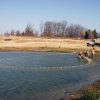 Baitfish Industry
Baitfish Industry Environment
Environment Home Demonstration Clubs
Home Demonstration Clubs Lavacaberry
Lavacaberry Official State Fruit and Vegetable
Official State Fruit and Vegetable Official State Soil
Official State Soil Texas Tick Fever Eradication
Texas Tick Fever Eradication Vestal Nursery
Vestal Nursery Ben Altheimer
Ben Altheimer 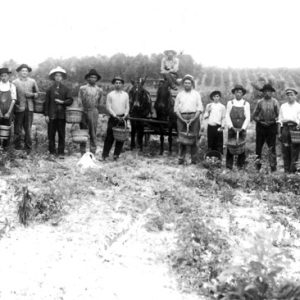 Amity Peach Pickers
Amity Peach Pickers  Arkansas City Cotton Picker
Arkansas City Cotton Picker  Arkansas Farm Bureau, Negro Division
Arkansas Farm Bureau, Negro Division  Baitfish Vat
Baitfish Vat  Corning Grain Silos
Corning Grain Silos  Cotton Boll Weevil
Cotton Boll Weevil 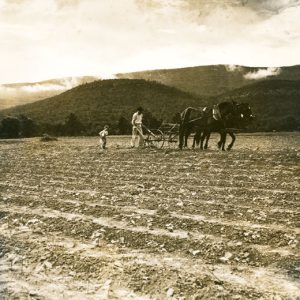 Plowing a Cotton Field
Plowing a Cotton Field  Cotton Pickers
Cotton Pickers 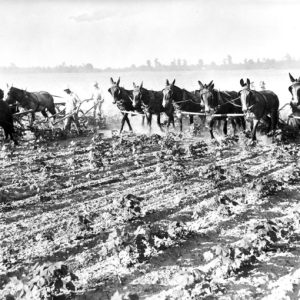 Cultivating Cotton
Cultivating Cotton  William Fuller
William Fuller  William Fuller on Levee Pusher
William Fuller on Levee Pusher  Jake Hartz, Jr.
Jake Hartz, Jr.  Judsonia Strawberry Wagons
Judsonia Strawberry Wagons  Lake Dick Cotton Baler
Lake Dick Cotton Baler  Lavacaberry Crate Label
Lavacaberry Crate Label  Lowell Apple Evaporator
Lowell Apple Evaporator  Marshall Strawberry Pickers
Marshall Strawberry Pickers  Miller County Farming Machinery
Miller County Farming Machinery 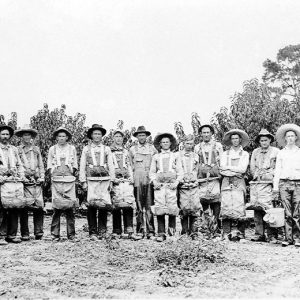 Nashville Peach Pickers
Nashville Peach Pickers 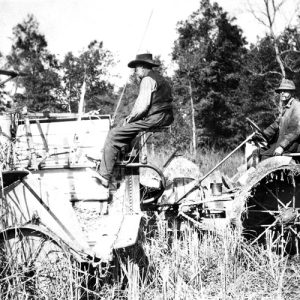 Rice Harvesting
Rice Harvesting  Rice Harvesting
Rice Harvesting  Rice, Official State Grain
Rice, Official State Grain  Rogers Apple Pickers
Rogers Apple Pickers  Rogers Broiler Show
Rogers Broiler Show  Sharecropper
Sharecropper  Sheeks-Stephens Gin
Sheeks-Stephens Gin  Southern Tenant Farmers' Union
Southern Tenant Farmers' Union 




You briefly mention free range of cattle in the nineteenth century in association with tenant/sharecropper farmers and say that beef cattle were often kept on free range prior to World War II, but I didn’t notice any mention of free-range hogs in upland/GCP areas of Arkansas. This started well before the Civil War and continued through the mid-twentieth century, and was widespread–virtually every hill farmer of this period ear-notched hogs and turned them loose in the woods, gathered them up in the fall/early winter, and then butchered them. Smokehouses (very common) were used to preserve the meat for the large rural families of this period. While the hog industry did not come close to approaching the cattle or poultry industry after WWII, it was a huge part of rural life for over 100 years.